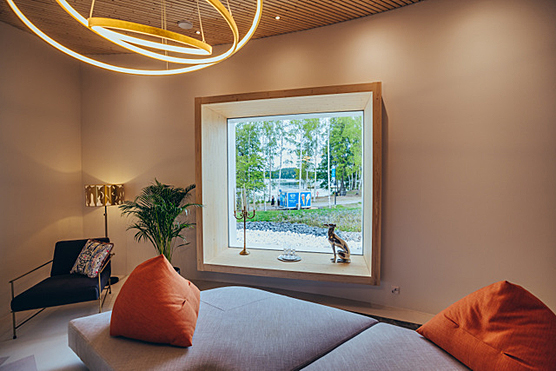
© Photo: Lohja Housing Fair.
The carbon footprints and carbon handprints of houses in Hiidensalmi have been calculated using the Ministry of the Environment's updated low-carbon assessment method. The life cycle review makes visible how the many choices made by the builder affect the carbon footprint of the entire life cycle of the house.
“By providing building instructions and commenting on the plans, we have guided builders from the beginning to take the climate perspective into account in a comprehensive way to reduce emissions from construction, housing and mobility,” says Mirka Härkönen, Project Manager at Lohja Housing Fair.
The carbon footprint and carbon handprint calculations in Hiidensalmi were carried out by Granlund Oy. At the same time, Granlund was the first in Finland to test the updated low-carbon assessment method for a building on behalf of the Ministry of the Environment. Carbon footprint describes the negative climate impact of a building's entire life cycle. Carbon handprint means the potential climate benefits of a building. For example, a building can generate surplus solar energy for others to use.
The carbon footprint of the Hiidensalmi houses is reduced with energy and material choices
“There were significant variations in the carbon footprints of the Hiidensalmi houses. The carbon footprint of the houses ranged from 11 to 23 kg CO2e/m2/a. The average result for one-family houses was 14 kg CO2e/m2/a. The size of the carbon footprint depends above all on the choice of and the need for materials, energy efficiency and the method of energy generation. The type of building also matters, as the emissions per square metre of apartment buildings are significantly higher than those of a typical one-family house. Since calculations have not been made with the updated calculation method before, comparisons can only be made later,” says Tytti Bruce-Hyrkäs from Granlund Oy.
A building’s climate emissions and carbon footprint are most affected by the energy consumption during the use time and the emissions from the production of materials. Typically, half of the climate impact is caused by the production of materials.
“From a climate perspective, the Hiidensalmi area has very comprehensive solutions with focus on both energy and material choices. From the point of view of climate impact, the best sites have used lightweight structures, wood products or materials containing recycled materials and utilised heat pumps. In some of the sites, energy efficiency is also A-class,” says Bruce-Hyrkäs.
Decisions affecting the carbon footprint and carbon handprint already at the beginning of the construction projectVisualisation of the results of the low-carbon assessment of a concrete-framed housing fair site. The calculation takes into account organic carbon binding at the product stage and release at the end of the life cycle. In 15 years, one Finn produces roughly the same amount of greenhouse gas emissions as the detached house in Hiidensalmi in the example during its entire life cycle.
In terms of greenhouse gas emissions throughout the entire life cycle of a house, it is essential to include the climate perspective in the design of the new house as early as possible.
“For example, a low-emission heating system and the utilisation of solar energy should be taken as a starting point already in planning,” says Jarmo Linjama, Development Engineer at SYKE. “Solar energy is an excellent aid to heating and source of domestic hot water. With the combination of solar power and a heat pump, you can cool your house in the summer free of charge and without emissions.”
It is possible to reduce emissions in all buildings; the means only vary depending on the site. “For example, emissions from a stone house can be significantly reduced when low-emission concrete with recycled binders is chosen as the building material,” says Bruce-Hyrkäs.
Climate-friendly construction does not necessarily increase the cost to the builder. “The price of construction always depends on, among other factors, the place of construction and the desired features of the site. Starting the planning well in advance makes it easier to manage costs. Of course, some climate solutions are more expensive than conventional alternatives,” says Bruce-Hyrkäs.
“Highlighting the carbon footprint to the visitors of the Housing Fair creates an opportunity to reflect on the importance of choices both in construction and during housing. We hope that the information will encourage people to make green choices and companies to bring climate-friendly and environmentally sustainable construction products to the market,” sums up Project Manager of the Canemure project Jenna Kotilehto from the City of Lohja.
Those who have purchased an exhibition ticket will still be able to visit the exhibition homes at the virtual Housing Fair, and soon the virtual gates will also be opened to others interested in new perspectives on housing. All site-specific carbon footprint reports have been included in the site presentations in the virtual fair.
Learn more
More information
- Climate perspective for the 2021 Lohja Housing Fair: Project Manager Jenna Kotilehto, Canemure project, City of Lohja, jenna.kotilehto@lohja.fi, tel. +358 44 369 4488
- Carbon footprint and carbon handprint calculation in Hiidensalmi: Head of Carbon Neutrality Tytti Bruce-Hyrkäs, Granlund Oy, tytti.bruce-hyrkas@granlund.fi, tel. +358 500 655 020
- Low-carbon construction: Development Engineer Jarmo Linjama, Finnish Environment Institute, jarmo.linjama@syke.fi, tel. +358 295 251 38